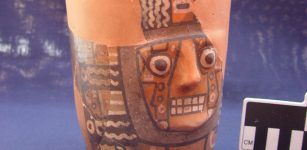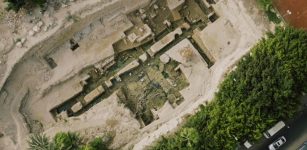Sobek – Enigmatic Crocodile God Of Ancient Egypt
A. Sutherland - AncientPages.com -Sobek (also spelled Sebek, in Greek' Suchos') was, in ancient Egyptian religion, a god of the violent power embodied in crocodiles and his chief sanctuary, located in Faiyum province.
 This relief from the Temple of Kom Ombo shows Sobek with typical attributes of kingship, including a was-scepter and royal kilt. The ankh in his hand represents his role as an Osirian healer and his crown is a solar crown associated with one of the many forms of Ra. Image credit: Hedwig Storch - CC BY-SA 3.0
This relief from the Temple of Kom Ombo shows Sobek with typical attributes of kingship, including a was-scepter and royal kilt. The ankh in his hand represents his role as an Osirian healer and his crown is a solar crown associated with one of the many forms of Ra. Image credit: Hedwig Storch - CC BY-SA 3.0
This powerful deity with many essential associations was worshiped from at least the Old Kingdom (c. 2700-2200 BC). According to the "Pyramid Texts," Sobek - the 'raging one' - is the son of the goddess Neith. He is the one who 'takes women from their husbands whenever he wishes but also makes green the herbage of the fields and river banks. (PT 507-10)
He is considered one of the oldest deities mentioned in the Pyramid Texts, inscribed on tomb walls. Sobek, the lord of the crocodiles, was depicted with a crocodile head.
Many believed Sobek created order in the universe and the world when he emerged from the "Dark Water" and that he was the creator of the Nile River. He was often associated with fertility. However, due to his somewhat unpredictable nature (ferocity and quick movements), the deity was also associated with chaos.
Who was this larger-than-life deity with the body of a man and the head of a crocodile? Did his worship originate in Faiyum, where he was known as the Lord of Faiyum?
Was Sobek an early fertility god or associated with death and burial before becoming a significant deity and patron of kings in the Middle Kingdom (c.1938–c. 1630 BC)?
Sobek was often shown wearing a plumed headdress with a horned sun disk or the Atef Crown. He was shown to carry a wand and the ankh sign of life in his hands. His sacred animal, the crocodile, was both revered and reviled by the people of Egypt - in some areas, a tame crocodile was worshiped as the god Sobek himself, while in other places, the reptiles were killed.
Left: Map of Egypt; Right: A wall relief from Kom Ombo showing Sobek with solar attributes. Right image credit: Hedwig Storch - CC BY-SA 3.0
Mummified crocodiles representing the god have been found in many ancient tombs. The Egyptians mummified both infant and mature crocodiles and even interred crocodile eggs and fetuses with the deceased to enlist the protection of Sobek in the afterlife.
The Egyptians seemed to both respect and fear the power of the crocodiles, which were not always seen as benevolent. Sometimes, they were believed to be messengers of Seth, the god of destruction.
With a complex nature, Sobek has ties to many other gods. He was associated with Horus because Horus took the form of a crocodile to retrieve the parts of Osiris' body that were lost in the Nile. Yet Sobek was also thought to have assisted Isis when she gave birth to Horus. He was also associated with the cults of specific other deities such as Amus, Osiris, and the sun god in the form of Sobek-Ra.
As often depicted wearing either the headdress of Amun or the sun disk of Ra, Sobek was worshiped as the manifestation of Amun-Re. However, he was also associated with Set, Osiris's enemy.
Legend has it that one of Egypt's first kings, Hor-Aha, built a temple to Sobek in the Faiyum. Sobek was also said to be 'Lord of Bakhu,' the mythological mountain of the horizon, and this epithet is frequently related to him.
The worship of Sobek continued into Ptolemaic and Roman times. Cemeteries of mummified crocodiles have been found in Faiyum and at Kawm. Even in Greco-Roman times, Sobek was honored.
In his Geography, Strabo discusses the Faiyum during his time as the city of Arsinoe, a.k.a. Crocodopolis (the City of the Crocodile). He says, "The people in this Nome hold in very great honor the crocodile, and there is a sacred one there which is kept and fed by itself in a lake and is tame to the priests."
The ancient Egyptians worshiped Sobek from the times of the Old Kingdom to the Roman Period, but the particular prominent time of this worship is dated to the Middle Kingdom. It is attested by the names of several rulers belonging to the 12th and 13th dynasties who had titles like Sobekneferu ("beautiful of Sobek") and Sobekhotep ("Sobek is satisfied").
Written by A. Sutherland - AncientPages.com Senior Staff Writer
Updated December 15, 2023
Copyright © AncientPages.com All rights reserved. This material may not be published, broadcast, rewritten or redistributed in whole or part without the express written permission of AncientPages.com
Expand for referencesHart, G. The Dictionary of Egyptian Gods and Goddesses
Gods and Goddesses of Ancient Egypt
More From Ancient Pages
-
 Early Humans Risked Life -Threatening Flintknapping Injuries – Long-Lasting Tradition
Archaeology | May 26, 2023
Early Humans Risked Life -Threatening Flintknapping Injuries – Long-Lasting Tradition
Archaeology | May 26, 2023 -
 Rare Discovery Of A 2,500-Year-Old Ancient Receipt With The Name Of King Darius The Great
Archaeology | Mar 2, 2023
Rare Discovery Of A 2,500-Year-Old Ancient Receipt With The Name Of King Darius The Great
Archaeology | Mar 2, 2023 -
 Amazing Archaeological Discovery In Washington Confirms Thousand-Year-Old Legend
Featured Stories | Jul 7, 2024
Amazing Archaeological Discovery In Washington Confirms Thousand-Year-Old Legend
Featured Stories | Jul 7, 2024 -
 Untold Story Of The Glencoe Massacre In 1692 Revealed By Archaeologists In Scotland
Archaeology | Dec 18, 2024
Untold Story Of The Glencoe Massacre In 1692 Revealed By Archaeologists In Scotland
Archaeology | Dec 18, 2024 -
 Surprise! ‘Viking Ship’ Found On The Seabed Is Not What We Previously Thought And Rewrites Scandinavian Maritime History, Scientists Say
Archaeology | Mar 10, 2025
Surprise! ‘Viking Ship’ Found On The Seabed Is Not What We Previously Thought And Rewrites Scandinavian Maritime History, Scientists Say
Archaeology | Mar 10, 2025 -
 Roman Theater Unearthed After 1,700 Years Near Western Wall In Jerusalem
Archaeology | Oct 19, 2017
Roman Theater Unearthed After 1,700 Years Near Western Wall In Jerusalem
Archaeology | Oct 19, 2017 -
 Garamantes: 3,000-Year-Old Sophisticated North African Society Built 3,000-Mile Network Of Underground Irrigation Canals
Featured Stories | Nov 10, 2025
Garamantes: 3,000-Year-Old Sophisticated North African Society Built 3,000-Mile Network Of Underground Irrigation Canals
Featured Stories | Nov 10, 2025 -
 Evolution Study Re-Writes History – Why Were Some Early Male Ancestors Significantly Larger Than Females?
Evolution | Jul 30, 2025
Evolution Study Re-Writes History – Why Were Some Early Male Ancestors Significantly Larger Than Females?
Evolution | Jul 30, 2025 -
 Extraordinary Ancient Mosaics, Crucifixes, And Long-Lost Church Discovered In The Holy Land
Archaeology | Dec 22, 2017
Extraordinary Ancient Mosaics, Crucifixes, And Long-Lost Church Discovered In The Holy Land
Archaeology | Dec 22, 2017 -
 William The Conqueror: Ruthless And Powerful Ruler Who Changed Britain Forever
Featured Stories | Feb 25, 2023
William The Conqueror: Ruthless And Powerful Ruler Who Changed Britain Forever
Featured Stories | Feb 25, 2023 -
 On This Day In History: Charlemagne King Of The Franks And Emperor Of The Holy Roman Empire Born – On April 2, 742
News | Apr 2, 2017
On This Day In History: Charlemagne King Of The Franks And Emperor Of The Holy Roman Empire Born – On April 2, 742
News | Apr 2, 2017 -
 Home Of The Gods – The Return Of The Gods – Part 3
Ancient Mysteries | Jun 14, 2018
Home Of The Gods – The Return Of The Gods – Part 3
Ancient Mysteries | Jun 14, 2018 -
 Ancient Pottery Reveal How Peru’s First Great Empire Wari Functioned
Archaeology | Mar 14, 2023
Ancient Pottery Reveal How Peru’s First Great Empire Wari Functioned
Archaeology | Mar 14, 2023 -
 Cacao Originated 1,500 Years Earlier Than Previously Thought And Comes From South America
Archaeology | Oct 30, 2018
Cacao Originated 1,500 Years Earlier Than Previously Thought And Comes From South America
Archaeology | Oct 30, 2018 -
 Goddess Huitaca – Moon Goddess Of Intoxication, Joyful Life And Unlimited Pleasures In Muisca Mythology
Featured Stories | Mar 14, 2021
Goddess Huitaca – Moon Goddess Of Intoxication, Joyful Life And Unlimited Pleasures In Muisca Mythology
Featured Stories | Mar 14, 2021 -
 Ancient Urartu Settlement, Water Tunnel And Rock Tombs Found In Erzurum, Eastern Turkey
Archaeology | Dec 19, 2017
Ancient Urartu Settlement, Water Tunnel And Rock Tombs Found In Erzurum, Eastern Turkey
Archaeology | Dec 19, 2017 -
 Longstanding Cultural Continuity At Oldest Occupied Site In West Africa – New Study
Archaeology | May 4, 2023
Longstanding Cultural Continuity At Oldest Occupied Site In West Africa – New Study
Archaeology | May 4, 2023 -
 Archaeologists Have Discovered A Mummy Wrapped In Gold – Here’s What It Tells Us About Ancient Egyptian Beliefs
Featured Stories | Feb 7, 2023
Archaeologists Have Discovered A Mummy Wrapped In Gold – Here’s What It Tells Us About Ancient Egyptian Beliefs
Featured Stories | Feb 7, 2023 -
 Discovery: Massive Gawro Wall Dated To The Antique Age: Was It A Symbolic Or Defensive Structure?
Archaeology | Nov 9, 2019
Discovery: Massive Gawro Wall Dated To The Antique Age: Was It A Symbolic Or Defensive Structure?
Archaeology | Nov 9, 2019 -
 New Hope To Finally Find Tomb Of Alexander The Great
Archaeology | Mar 6, 2019
New Hope To Finally Find Tomb Of Alexander The Great
Archaeology | Mar 6, 2019

